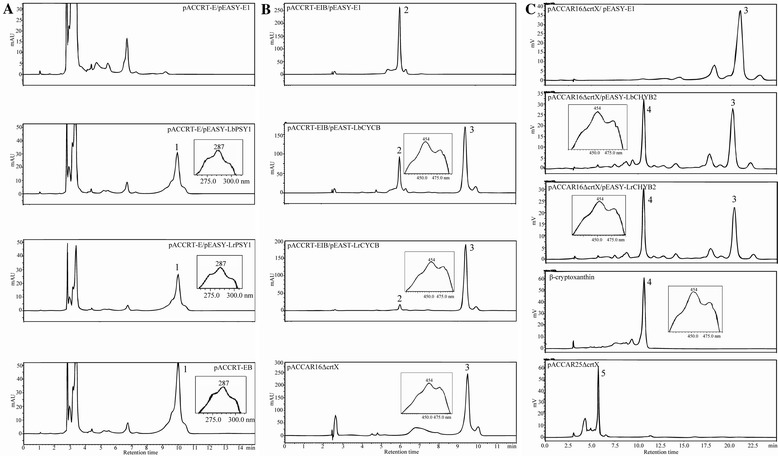Figure 6.

Pigments produced in E. coli in the functional analysis for PSY1, CYC-B and CRTR-B2 of both species. In the functional analysis of PSY1 (A), pigments extracted from E. coli cells harboring pACCRT-E, the engineered plasmid producing GGPP, and pEASY-E1, the empty vector; plasmids pACCRT-E and pEASY-LbPSY1, which encodes LbPSY1; plasmids pACCRT-E and pEASY-LrPSY1, which encodes LrPSY1; and pACCRT-EB, the engineered plasmid producing phytoene (peak 1) as a positive control. The absorption spectra of phytoene are presented in the boxes with retention times of 10.0 min. In the functional analysis of CYC-B (B), the plasmids are pACCRT-EIB, the engineered plasmid producing lycopene (peak 2), and pEASY-E1; pACCRT-EIB and pEASY-LbCYC-B, which encodes LbCYC-B; pACCRT-EIB and pEASY-LrCYC-B, which encodes LrCYC-B; and pACCAR16ΔcrtX, the engineered plasmid producing β-carotene (peak 3) as a positive control. The absorption spectra of β-carotene are presented in the boxes with retention times of 9.4 min. In the functional analysis of CRTR-B2 (C), the plasmids are pACCAR16ΔcrtX (producing β-carotene, peak 3) and pEASY-E1; pACCAR16ΔcrtX and pEASY-LbCRTR-B2, which encodes LbCRTR-B2; pACCAR16ΔcrtX and pEASY-LrCRTR-B2, which encodes LrCRTR-B2; and pACCAR25ΔcrtX, the engineered plasmid producing zeaxanthin (peak 5). Beta-cryptoxanthin standard was used as the indicator of peak 4. The absorption spectra of β-cryptoxanthin are presented in the boxes with retention times of 10.5 min.
